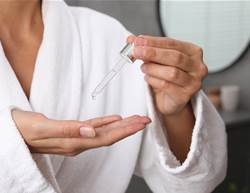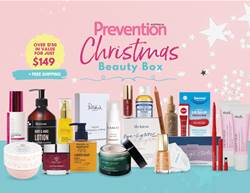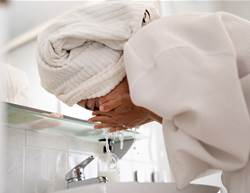In 2025, the methods for achieving better and brighter skin are vast. From slathering on snail mucin to slugging (which is something different altogether) to red light therapy, there is no shortage of techniques. Now, PRP facial treatments, also known as “vampire facials,” are getting buzz for their ability to renew your complexion. But a new report links the blood-containing treatment to three cases of HIV—so is it safe?
Here, experts explain what exactly a PRP facial treatment is, share the potential benefits and risks, and weigh in on the recent public health concerns surrounding the controversial skincare trend.
What is a “vampire facial,” aka PRP treatment?
PRP stands for platelet-rich plasma, says dermatologist Dr Peterson Pierre. “Plasma is a component of your blood that contains proteins and other factors involved in healing and cell growth.”
A PRP facial injects the patient’s own platelet-rich plasma into the face using a device with microneedles. To acquire your own plasma for the treatment, your blood is drawn, spun down and the concentrated plasma is separated, Dr Pierre explains.
As the plasma is rich in growth factors, the procedure may help accelerate wound healing, stimulate collagen, improve hyperpigmentation and boost overall skin quality, says double board-certified dermatologist Karan Lal.
What is a PRP facial experience like?
When you sign up for a PRP facial, the first thing you can expect is to get your blood drawn. In fact, usually 15–30 mL of blood is drawn, says Dr Lal, and as with typical blood drawing, it may be uncomfortable.
After blood is drawn from the patient, it is spun down in a centrifuge, the PRP is separated, then reinjected into the targeted area (face or scalp) using an instrument with many tiny needles, says board-certified dermatologist Dr Mona Gohara. “The needles make punctures in the skin so that the PRP can get infused.”
There is some discomfort involved in undergoing multiple small injections all over the face, notes Dr Pierre, so many patients consider using a topical anaesthetic during the procedure.
Benefits of a PRP facial treatment
PRP facial treatments are typically used to rejuvenate and plump the skin while stimulating cellular growth, which can lead to increased collagen and elastin production along with cellular repair, says Dr Pierre, and studies have backed this up. As people age, their bodies produce less collagen, which can lead to wrinkles, loss of elasticity and other signs of ageing. Therefore, stimulating collagen production may:
- Lessen the appearance of wrinkles
- Plump sagging skin
- Keep your complexion looking smooth
- Minimise acne scars, according to Dr Gohara
- Aid in hair growth when injected into the scalp
Research has shown that the combination of microneedling and PRP can significantly decrease the severity of acne scars. And if PRP is injected into the scalp, it may promote hair growth, says Dr Gohara. A 2022 review backed this up when researchers found that PRP could stimulate hair growth and thickness, as well as protect hair follicles from premature shedding.
For darker skin tones, PRP facials may improve hyperpigmentation and acne scars, says Dr Lal. However, Dr Gohara notes that the treatment should always be performed by a board-certified dermatologist to minimise the risk of scarring.
Undergoing a PRP facial may also help reduce downtime from procedures such as microneedling and laser resurfacing, adds Dr Lal.
Potential risks of a PRP facial
According to Dr Gohara, “vampire facial” risks, aka PRP treatment, may include:
- Infection
- Irritation
- Inflammation
- Scarring
Infection is by far the most serious risk of a PRP facial, says Dr Lal, “especially if an aseptic technique is not employed.” Some people may break out after PRP treatments, he adds, but Dr Lal notes that this is usually temporary and resolves quickly.
What are the risks involving HIV and PRP facials?
The CDC recently released a report on HIV transmission linked to PRP facial treatments performed at an unlicensed medical spa in New Mexico. The investigation found that three people contracted HIV infections from PRP facials at the spa due to unsterile practices. Public health officials discovered that the spa allegedly reused disposable equipment meant for single use. These are believed to be the first documented cases of people contracting HIV through a cosmetic procedure involving needles.
PRP facial treatment is a blood-based procedure that involves needles, says Dr Gohara. “However, the transmission linked to New Mexico occurred at an unlicensed med spa. This treatment should only be performed in a board-certified dermatology clinic where protocols for safety and infection control are standard practice and taken seriously,” she explains. In the hands of a trained dermatologist, this is a low-risk procedure, Dr Gohara notes.
To further clarify, the blood used during a “vampire facial” should be your own. So, there is no risk of contracting HIV from another person. PRP is an autologous procedure, says Dr Lal, “meaning YOUR blood is applied to your skin.” He adds, “We do not apply someone else’s blood or use contaminated needles. Unsafe practices put you at risk for hepatitis B, hepatitis C and HIV.”
Who should avoid a PRP facial treatment?
In general, anyone with inflamed skin from acne or rosacea, active skin infections or highly sensitive skin should avoid PRP facials, says Dr Gohara.
Additionally, if you have a low pain tolerance or bruise easily, you may want to reconsider the treatment, says Dr Pierre.
How much does a PRP facial cost?
If you’re considering a PRP facial at a licensed, board-certified dermatology clinic, be prepared for a significant price tag. Dr Lal notes that costs vary depending on your location and provider. A dermatologist-led procedure will typically be more expensive than a med spa treatment, he adds. However, experts still advise seeing a licensed dermatologist for the safest experience.
According to Dr Pierre, the average cost of a “vampire facial” is about AU$2,000, “but prices can range between AU$1,400 and $4,000.”
The bottom line
RP facial treatments can be safe and effective if performed by board-certified dermatologists, says Dr Gohara. So, if you’re curious whether a PRP facial can improve your complexion, ask your dermatologist if it’s the right choice for you.










